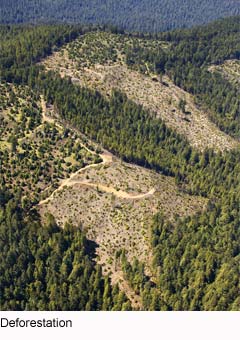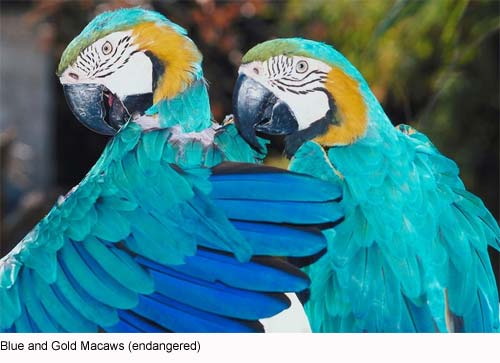Extinction Occurs Naturally? For the 3.5 billion years that life has existed on earth, species of plants and animals have come and gone. Through the process of evolution, more successful types of animals replace those that are less successful. In fact, scientists estimate that for every species alive today, 10,000 of its primitive relatives have become extinct.
Accelerated Extinction: Extinction occurs naturally, but human activity has dramatically increased the rate of extinction. Due to man-made causes, the current rate of extinction is thousands of times greater than it would be naturally. This article will focus on the damaging impact of habitat loss. To learn about the top 7 causes of animal extinction, click here!
 Habitat Loss: Enemy #1... While tropical rainforests cover less than 10 percent of the Earth’s surface, they support over half of all living plant and animals. The rainforests in Central and South America, Africa, and Southeast Asia are home to millions of species! Coral reefs, nicknamed the “rainforests of the sea,” contain one-quarter of all sea life. Habitat Loss: Enemy #1... While tropical rainforests cover less than 10 percent of the Earth’s surface, they support over half of all living plant and animals. The rainforests in Central and South America, Africa, and Southeast Asia are home to millions of species! Coral reefs, nicknamed the “rainforests of the sea,” contain one-quarter of all sea life.
Humans have destroyed over half of the Earth’s forests, and the African and South American rain forests are disappearing at a frightening rate. Since all creatures need space in which to live, find food, and reproduce, habitat loss is the biggest threat to wildlife today.
Not For the Birds: By far, human development and agriculture is the largest threat to native bird populations. For example, over 95 percent of the U.S.’ Tallgrass Prairie habitat has been destroyed in the past two centuries. When aquatic habitats are drained or filled in and dry habitats are transformed, native bird populations often plummet. Exotic bird species, introduced predators, hunting, and pollution are also serious threats to native bird species.

Unfit Habitats? Many small American national parks have lost mammal
species because they are too small to maintain breeding populations. For this reason, one large nature reserve is often better than three small reserves that add up to the same size. Less than half of earth’s remaining forests are large enough to support many woodland plant and animal species. Even when enough food is available, small isolated animal populations can die out because of inbreeding.
What's the Solution? Sustainable resource use means that, when people harvest natural resources, they leave enough to ensure that the depleted populations can recover. Through sustainable resource use, humans can save many of the world’s endangered animals! For example, Blue Whales were brought back from the brink of extinction through an international agreement limiting the amount of whale harvesting. Even without international agreements, individuals can help out by purchasing products that are made with sustainable sources, i.e. sources that will recover after they are harvested. To learn about how conservationists help endangered animals, click here!

|

